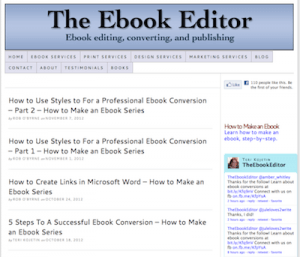 Chris O’Byrne, a.k.a. the “E-Book Editor” has provided some WWW clients with great pricing on ebook conversions. Right now, Chris and co. have a fabulous “How to Make an EBook Series” running on their blog. As a followup to Tammy Salyer’s great post on Sunday, November 11, “How to Digitally Format Your Book,” we thought readers might enjoy exploring the down and dirty of preparing your own e-book:
Chris O’Byrne, a.k.a. the “E-Book Editor” has provided some WWW clients with great pricing on ebook conversions. Right now, Chris and co. have a fabulous “How to Make an EBook Series” running on their blog. As a followup to Tammy Salyer’s great post on Sunday, November 11, “How to Digitally Format Your Book,” we thought readers might enjoy exploring the down and dirty of preparing your own e-book:
- 7 Tips to Perform Your Own Kindle Formatting Service for Your Ebook – How to Make an Ebook Series
- 5 Steps To A Successful Ebook Conversion – How to Make an Ebook Series
- How to Create Links in Microsoft Word – How to Make an Ebook Series
- How to Use Styles to For a Professional Ebook Conversion – Part 1 – How to Make an Ebook Series
- How to Use Styles to For a Professional Ebook Conversion – Part 2 – How to Make an Ebook Series
Enjoy, and tell us if you’ve formatted an ebook of your own and what pitfalls you may have run into?

When I created the Kindle file for my first self-pubbed YA novel, LOST IN THE ’90s, I decided to include a ton of links that would help the “young” reader learn more about the plethora of ’90s pop culture references I included in the story. (The majority of editors at the “real” publishing houses felt that “kids today” wouldn’t “get” who, say Jennifer Anniston was, or know what the short-lived TV show “The Heights” was. So I included links to various web pages, from celebrity websites to Wikipedia entries to YouTube videos of ’90s movie trailers.
It took a super long time to find all the links and make them active in my Word file. But after many long hours, the work was done and the e-book published. Then I discovered that not ALL the content — particularly the YouTube videos — was viewable on Kindle. I guess they block “third party content” and so there were certain links my e-book readers couldn’t access.
Not wanting to have a “bad” product out there on the market, I eventually ended up redesigning my Kindle file and took out all the links. Now LIT90s just reads like a “regular” book. But I do hope that young readers will take the initiative to look up the ’90s references they might not “get” on their own.